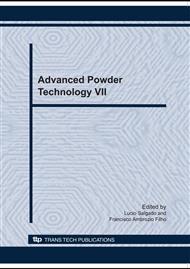p.771
p.777
p.784
p.788
p.794
p.801
p.807
p.813
p.819
Nanocomposite Microcapsules from Powders of Polyhydroxybutyrate (PHB) and Smectite Clays
Abstract:
Drug delivery systems involving microcapsules provide an attractive way to improve the performance of many chemical and biological substances. These systems may be used for several industrial segments, especially medical, pharmaceuticals and cosmetics. PHB is a polyhydroxyalkanoate available in powder form, biocompatible, biodegradable and inert towards animal tissues. The obtained PHB/smectite clay nanocomposite improved the physical-chemical properties of PHB, including its biodegradability. In this work, we describe the preparation of microcapsules from two nanocomposites systems: a) PHB and Cloisite 20A organoclay (PHB1) and b) PHB and natural Brazilian green policationic clay (PHB2). When analyzed by XRD, the films and microcapsules did not show a d(001) peak, demonstrating an exfoliated structure for the nanocomposites. The films have shown by SEM an homogeneous distribution with the clay mineral particles spread homogeneously by the PHB film. The new microcapsules/nanocomposites showed an “hydrangea” morphology. The diameter of the microcapsules was variable between 0.5-15 µm.
Info:
Periodical:
Pages:
794-798
Citation:
Online since:
October 2010
Keywords:
Price:
Сopyright:
© 2010 Trans Tech Publications Ltd. All Rights Reserved
Share:
Citation:


